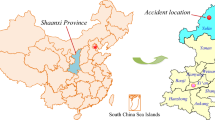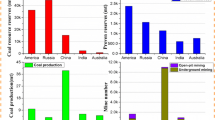Abstract
Coal fire is a global catastrophe. Xinjiang suffers the most severe coal fire in China and even in the world. Coal firefighting work has been being conducted for decades in Xinjiang. In this paper, coal fire detection, extinguishing, and monitoring approaches that were derived from coal firefighting experience are introduced in detail by taking the Fifth Fire Area (FFA) of the Heshituoluogai coal fire for instance. We first introduce the geology and fire situation in the FFA. Before developing efficient strategies to extinguish it, magnetic and self-potential methods are adopted to delineate the extent of the fire. A composite index is proposed to better indicate the fire. The comprehensive coal firefighting method is illustrated in detail, which consists of surface cooling, excavation and leveling, borehole drilling, borehole water injection and grouting, and loess backfill. The subsequent temperature and CO monitoring records show that the fire is extinguished successfully without burnback. The methodology presented here provides guidance and reference for putting out other coal fires around the world.














Similar content being viewed by others
References
Adamus A (2002) Review of the use of nitrogen in mine fires. Min Technol 111:89–98
Chamberlain EAC, Barrass G, Thirlaway JT (1976) Gases evolved and possible reactions during low-temperature oxidation of coal. Fuel 55:217–223
Chatterjee RS (2006) Coal fire mapping from satellite thermal IR data—a case example in Jharia Coalfield, Jharkhand, India. Isprs Journal of Photogrammetry & Remote Sensing 60:113–128
Cheng W, Hu X, Xie J, Zhao Y (2017) An intelligent gel designed to control the spontaneous combustion of coal: fire prevention and extinguishing properties. Fuel 210:826–835
Dai S, Ren D, Tang Y, Shao L, Li S (2002) Distribution, isotopic variation and origin of sulfur in coals in the Wuda coalfield, Inner Mongolia, China. Int J Coal Geol 51:237–250
Deng J, Xiao Y, Lu J, Wen H, Jin Y (2015) Application of composite fly ash gel to extinguish outcrop coal fires in China. Nat Hazards 79:881–898
Engle MA, Radke LF, Heffern EL, O'Keefe JM, Hower JC, Smeltzer CD, Hower JM, Olea RA, Eatwell RJ, Blake DR (2012) Gas emissions, minerals, and tars associated with three coal fires, Powder River Basin, USA. Sci Total Environ 420:146–159
Finkelman R, Stracher G (2011) Environmental and health impacts of coal fires. Coal and Peat Fires: A Global Perspective: Coal—Geology and Combustion 1:115–125
Finkelman RB (2004) Potential health impacts of burning coal beds and waste banks. Int J Coal Geol 59:19–24
Heffern E, Coates D (2004) Geologic history of natural coal-bed fires, Powder River basin, USA. Int J Coal Geol 59:25–47
Hower JC, O'Keefe JM, Henke KR, Wagner NJ, Copley G, Blake DR, Garrison T, Oliveira ML, Kautzmann RM, Silva LF (2013) Gaseous emissions and sublimates from the Truman Shepherd coal fire, Floyd County, Kentucky: a re-investigation following attempted mitigation of the fire. Int J Coal Geol 116:63–74
Hu ZX, Hu XM, Cheng WM, Zhao YY, Wu MY, (2018) Performance optimization of one-component polyurethane healing agent for self-healing concrete. Construction and Building Materials 179:151-159
Künzer C (2005) Demarcating coal fire risk areas based on spectral test sequences and partial unmixing using multi sensor remote sensing data. Technical University Vienna, Austria
Kuenzer C, Zhang J, Tetzlaff A, Van Dijk P, Voigt S, Mehl H, Wagner W (2007) Uncontrolled coal fires and their environmental impacts: investigating two arid mining regions in north-central China. Appl Geogr 27:42–62
Kuenzer C, Hecker C, Zhang J, Wessling S, Wagner W (2008) The potential of multidiurnal MODIS thermal band data for coal fire detection. Int J Remote Sens 29:923–944
Kuenzer C, Stracher GB (2012) Geomorphology of coal seam fires. Geomorphology 138:209–222
Lu Y, Qin B (2015) Experimental investigation of closed porosity of inorganic solidified foam designed to prevent coal fires. Adv Mater Sci Eng 2015
O'Keefe JM, Henke KR, Hower JC, Engle MA, Stracher GB, Stucker J, Drew JW, Staggs WD, Murray TM, Hammond ML III (2010) CO2, CO, and Hg emissions from the Truman Shepherd and Ruth Mullins coal fires, eastern Kentucky, USA. Sci Total Environ 408:1628–1633
PB (2017) BP statistical review of world energy
Pone JDN, Hein KA, Stracher GB, Annegarn HJ, Finkleman RB, Blake DR, McCormack JK, Schroeder P (2007) The spontaneous combustion of coal and its by-products in the Witbank and Sasolburg coalfields of South Africa. Int J Coal Geol 72:124–140
Qin B, Lu Y, Li F, Jia Y, Zhu C, Shi Q (2014) Preparation and stability of inorganic solidified foam for preventing coal fires. Adv Mater Sci Eng 2014
Rathore C, Wright R (1993) Monitoring environmental impacts of surface coal mining. Int J Remote Sens 14:1021–1042
Ray S, Singh R (2007) Recent developments and practices to control fire in undergound coal mines. Fire Technol 43:285–300
Schneider W (1996) The coal-bearing Jurassic at the southern margin of the Junggar basin, Xinjiang. GEOWISSENSCHAFTEN-WEINHEIM 14:285–288
Shao Z, Wang D, Wang Y, Zhong X (2014) Theory and application of magnetic and self-potential methods in the detection of the Heshituoluogai coal fire, China. J Appl Geophys 104:64–74
Shao Z, Wang D, Wang Y, Zhong X, Tang X, Hu X (2015) Controlling coal fires using the three-phase foam and water mist techniques in the Anjialing Open Pit Mine, China. Nat Hazards 75:1833–1852
Shao Z, Wang D, Wang Y, Zhong X, Tang X, Xi D (2016) Electrical resistivity of coal-bearing rocks under high temperature and the detection of coal fires using electrical resistance tomography. Geophys J Int 204:1316–1331
Shao Z, Revil A, Mao D, Wang D (2017) Induced polarization signature of coal seam fires. Geophys J Int 208:1313–1331
Shi B, Zhou F (2014) Impact of heat and mass transfer during the transport of nitrogen in coal porous media on coal mine fires. Sci World J 2014:1–9
Song Z, Kuenzer C (2014) Coal fires in China over the last decade: a comprehensive review. Int J Coal Geol 133:72–99
Song Z, Kuenzer C, Zhu H, Zhang Z, Jia Y, Sun Y, Zhang J (2015) Analysis of coal fire dynamics in the Wuda syncline impacted by fire-fighting activities based on in-situ observations and Landsat-8 remote sensing data. Int J Coal Geol 141:91–102
Stracher GB (2004) Coal fires burning around the world: a global catastrophe. Int J Coal Geol 59:1–6
Stracher GB, Taylor TP (2004) Coal fires burning out of control around the world: thermodynamic recipe for environmental catastrophe. Int J Coal Geol 59:7–17
Stracher GB, Nolter MA, Schroeder P, McCormack J, Blake DR, Vice DH (2006) The great Centralia mine fire: a natural laboratory for the study of coal fires. Field Guides 8:33–45
Stracher GB, Prakash A, Rein G (2015) Coal and peat fires: a global perspective: volume 4: peat–geology, combustion, and case studies. Elsevier
Van Dijk P, Zhang J, Jun W, Kuenzer C, Wolf K-H (2011) Assessment of the contribution of in-situ combustion of coal to greenhouse gas emission; based on a comparison of Chinese mining information to previous remote sensing estimates. Int J Coal Geol 86:108–119
Whitehouse AE, Mulyana AAS (2004) Coal fires in Indonesia. Int J Coal Geol 59:91–97
Yan J (2018) Current status and management of coal fire in Xinjiang. Shaanxi Coal 1:71–73
Zeng Q, Tiyip T, Wuttke MW, W-m G (2015) Modeling of the equivalent permeability for an underground coal fire zone, Xinjiang region, China. Nat Hazards 78:957–971
Zhang J, Wagner W, Prakash A, Mehl H, Voigt S (2004) Detecting coal fires using remote sensing techniques. Int J Remote Sens 25:3193–3220
Zhang J, Kuenzer C (2007) Thermal surface characteristics of coal fires 1 results of in-situ measurements. J Appl Geophys 63:117–134
Zhang J, Kuenzer C, Tetzlaff A, Oertel D, Zhukov B, Wagner W (2007) Thermal characteristics of coal fires 2: results of measurements on simulated coal fires. J Appl Geophys 63:135–147
Zhang Q, Hu XM, Wu MY, Zhao YY, Yu C (2018) Effects of different catalysts on the structure and properties of polyurethane/water glass grouting materials. Journal of Applied Polymer Science 135 (27):46460
Funding
The project was sponsored by the Fundamental Research Funds for the Central Universities (2018QNA02) and the Priority Academic Program Development of Jiangsu Higher Education Institutions (PAPD).
Author information
Authors and Affiliations
Corresponding author
Additional information
Responsible editor: Philippe Garrigues
Rights and permissions
About this article
Cite this article
Shao, Z., Jia, X., Zhong, X. et al. Detection, extinguishing, and monitoring of a coal fire in Xinjiang, China. Environ Sci Pollut Res 25, 26603–26616 (2018). https://doi.org/10.1007/s11356-018-2715-6
Received:
Accepted:
Published:
Issue Date:
DOI: https://doi.org/10.1007/s11356-018-2715-6




